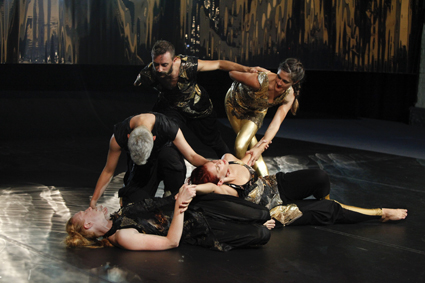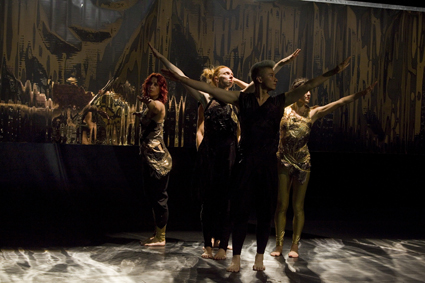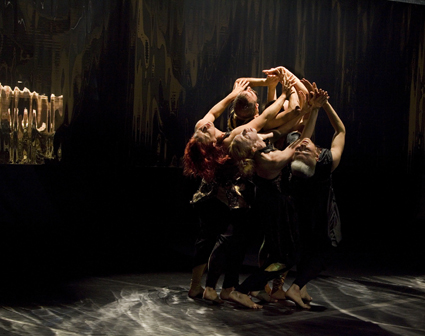 |
Future Perfect, Jo Lloyd photo Ponch Hawkes |
Curiously, as RealTime Associate Editor Gail Priest suggested to me, musically and costume-wise Lloyd looks back to a popular culture past in order to find the means to achieve transcendence now. Priest pointed to a similar impulse in Balletlab’s And All Things Return to Nature (which will be reviewed in RealTime 114; it was not part of the Dance Massive program).
The perfection offered by transcendence which is sought in Lloyd’s work is indeterminate, but it has religious connotations. The five dancers function with intense communality, as an organism of worship, arms reaching up uniformly, bodies forming tightly entwined clusters and lines with precise, darting head movements or hands raised in apparent supplication, or palms to palms, face to face signalling total togetherness. Precise, rapid movement, recurrent gestures and eyes filled with awe convey a frightening obsessiveness apt in an era of ever-burgeoning fundamentalisms. Occasionally the group flies apart, individuals spinning or gesticulating furiously, only to seamlessly reform with a common pulse.
 |
Future Perfect, Jo Lloyd photo Ponch Hawkes |
It’s the ending of Future Perfect that casts a pall over the hope that a shared spirituality can embody perfection, and there’s nothing at all funny about it. A recurrent motif has one of the group’s members falling to the floor, presumably in a state of ecstatic collapse. In a final sequence, each member moves towards the audience, topples, is quickly rescued, taken upstage and resurrected while another individual moves forward. This cycle is repeated but more darkly as the treatment of those who have fallen becomes less caring with individuals dragged away and wrestled to the floor. In the third cycle, care returns.
This last scene is highly ambiguous. A failure of ritual? The participants no longer look to the heavens, but out at the audience. Ecstasy, if that’s what it is, is short-lived and part of a struggle, devoid of the danced cohesion that opened Future Perfect. The prelude to this finale is a series of recorded utterances, prefiguring the ambiguity to come, including, “I just gave into it,” “I just wanted to go home. I wasn’t myself,” “I couldn’t feel my body,” “I was watching the community from the outside,” “It was all so perfect.”
Structurally, Future Perfect has strengths and weaknesses. The trajectory from tautly cohesive worship to crumbling ritual is strong, revealing a succession of states of being and means of expressing unity and transcendence. There’s even an odd folk like dance passage to an engaging musical chiming (distorting badly), not dissimilar in mood to a protracted left foot-right foot bouncing routine in Brooke Stamp’s equally ritualistic And All Things Return to Nature. There’s also a passage, prior to the final movement, in which this group of perhaps proselytising worshippers consumes more and more of the space around it, individual members preoccupied with their own moves.
Less structurally and thematically certain is the insertion of a video animation (Rhian Hinkley) duplicated on screens either side of the foil wall. It shows faces of some of the dancers in states of digital dissolution, sliced into stacked landscape-like layers or spinning slowly outwards in cosmic whorls. While interesting in itself, the video, presumably representing a sense of oneness with the universe, the ensuing blackout and the feeling of starting up again significantly disrupts the organic flow of Future Perfect.
 |
Future Perfect, Jo Lloyd photo Ponch Hawkes |
Doubtless Lloyd was not thinking so broadly, or deeply, about such matters, but Future Perfect suggested much in its own idiosyncratic way. As Stephanie Lake and Antony Hamilton have made clear in their realtime tv interviews, their aesthetic intentions were quite formal, abstract even, and they have been surprised at the sheer volume of literal interpretation applied to their works. Roland Barthes once wrote words to the effect that “denotation is the last of the connotations.” There’s a human impulse to constantly make sense, attaching the all too many signifiers that buzz about our brains to anything that does not immediately suggest meaning, and sooner or later we arrive at what ‘it’s about.’
In the work of Russell Dumas however you feel you’re simply seeing movement—although there are the often fascinating connotations of provenance: ballet, a broad spectrum of modern dance, contact improvisation and generations of Dumas-influenced dancers. There are even moments in Dance for the time being, as Virginia Baxter points out in her review, where a surprise movement is unusually suggestive.
Works by younger choreographers—Natalie Abbott’s Physical Fractals and Tim Darbyshire’s More or Less Concrete—refuse literal meaning because of their sheer strangeness, although the latter’s creation of some kind of strange organism (made up of three merging and de-merging performers) suggests incidental kinship with Gideon Obarzanek’s Glow and Mortal Engine and Antony Hamilton’s Black Project 2, as well as the clustering bodies in Lloyd’s Future Perfect.
Larissa McGowan’s Skeleton and Anouk Van Dijk’s 247 Days for Chunky Move, are clearly about something—young minds and bodies. But as Van Dijk says in her realtime tv interview, what seized her was the sudden oscillations in the psyches of people in their 20s between euphoria and despair, a suddenness she captures in her distinctive choreography and the structure of 247 Days (see Philipa Rothfield’s review). This lends the work an almost ritualistic fervour that resonates with the push for release and transcendence in the other works mentioned here and the slippage between individual states and compulsive togetherness, cosmically choral even in 247 Days.
However, when most dancing in Dance Massive which is bolstered by huge experimental musical compositions and wrap-around sounds that increasingly occupy the affective space of dance, only Tim Darbyshire deploys intense slowness of movement and subtle sonics that actually come from the dancers. Perhaps this is just another means to achieve a sense of immersion for the audience in an era preoccupied with achieving transcendence, secular or religious.
Dance Massive: Arts House & Jo Lloyd: Future Perfect, choreographer, director Jo Lloyd, performers Luke George, Madeleine Krenek, Shian Law, Jo Lloyd, Lily Paskas, lighting, set designer Jennifer Hector, music Duane Morrison, costumes Doyle Barrow, projection designer Rhian Hinkley, Arts House, Meat Market, Melbourne, March 20-24; http://dancemassive.com.au
© Keith Gallasch; for permission to reproduce apply to [email protected]








 back
back